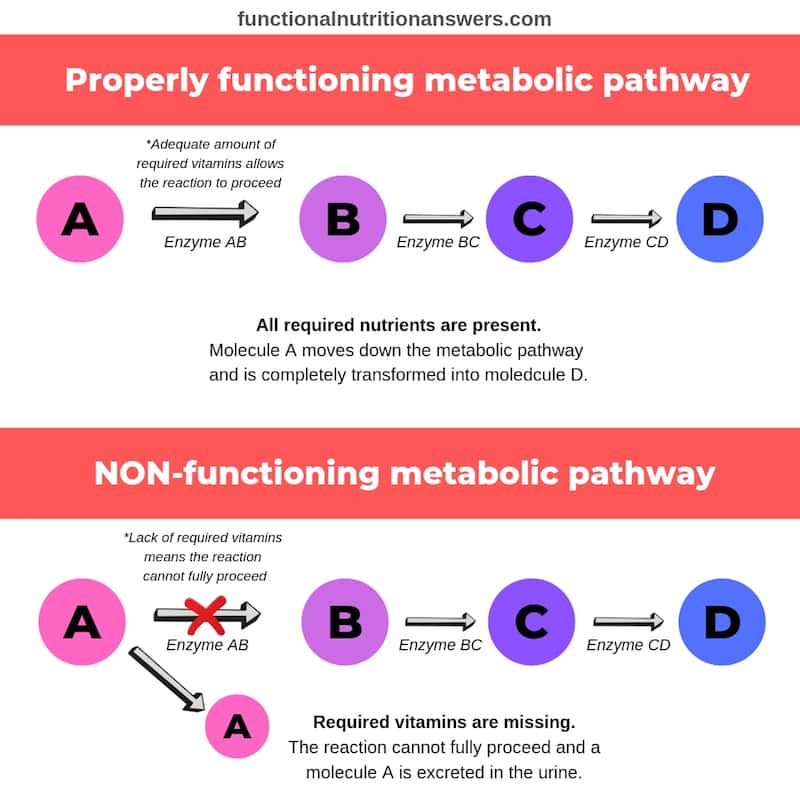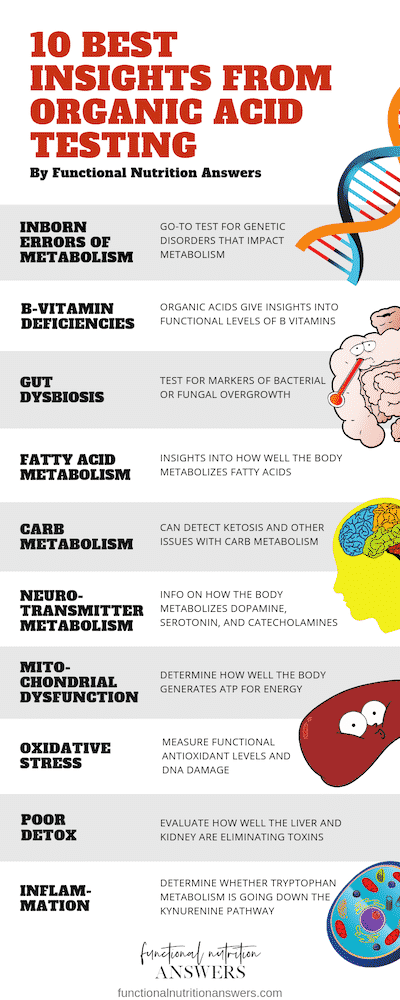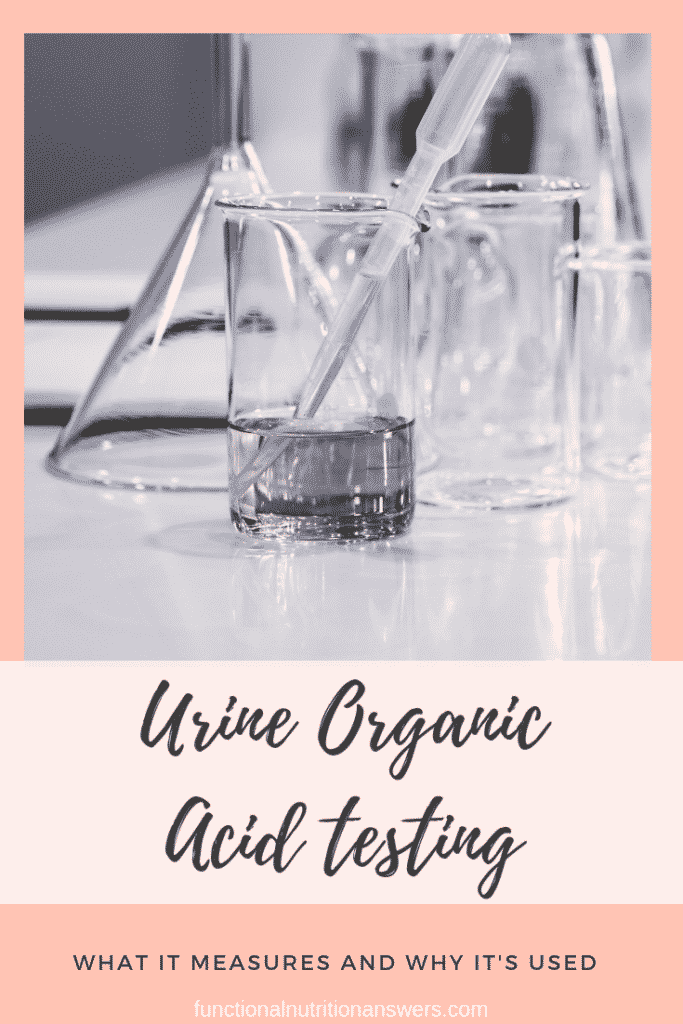Organic acid testing (OAT) has become very popular amongst functional medicine doctors and dietitians.
This urine-based test provides a wealth of information about the functioning of various bodily systems and can be used to identify possible nutrient deficiencies, gut dysbiosis, and more.
Keep reading to learn more about the science behind organic acid testing, who might benefit from it, and how to get tested.
Want to save this article? Click here to get a PDF copy delivered to your inbox.
Clickable Table of Contents
What Is an Organic Acid?
In humans, organic acids are byproducts or intermediates of chemical reactions that occur within the body (1).
The quantity (and sometimes the type) of organic acids produced are unique to each individual and can be influenced by a variety of factors.
Some factors that can influence organic acid production within the body include (2, 3):
-
- Diet
- Environmental toxins
- Gut microbes
- Genetics
- Kidney and liver function
- Medications
- Nutrient status
- Oxidative stress
In order for the body to run effectively, it needs proper amounts of vitamins and minerals to act as cofactors for enzymatic reactions.
Without enough of these nutritional cofactors (or if someone has genetic mutations that affect how well their enzymes work), these chemical pathways are unable to proceed at their normal pace.
As a result, organic acids begin to build up and are excreted in the urine:
Our urinary organic acid profiles can give us clues as to what’s happening in our bodies, and this is the basis of organic acid testing.
What Does a Urine Organic Acids Test Evaluate?
Organic acid testing (OAT) is often compared to performing an emissions test on a car.
For cars, the exhaust fumes that come out of the tailpipe are a byproduct of fuel combustion, and the composition can tell us how efficiently the engine burns fuel.
In the same way, organic acids in our urine are byproducts of our metabolism and can give us information about how efficiently our body systems are performing.
Reasons for Abnormal OAT Results
When the body isn’t functioning optimally, organic acids in the urine can become elevated or depleted, depending on what is occurring.
The main reasons for abnormal urinary organic acid results include:
-
- Inborn errors of metabolism
- B-vitamin deficiencies
- Gut dysbiosis
- Impaired fatty acid metabolism
- Ketosis or poor carbohydrate metabolism
- Neurotransmitter metabolism
- Mitochondrial dysfunction
- Oxidative stress
- Poor detoxification
- Inflammation
We’ll review each of these scenarios in detail below.
Reason #1: Inborn Errors of Metabolism
Inborn errors of metabolism are genetic disorders that disrupt biochemical pathways in the body (1).
These disorders are rare, but their effects can be devastating (4).
Often, there is a defect in a gene that codes for a certain enzyme, causing the body to either produce malfunctioning enzymes or none of the enzymes at all.
These missing or malfunctioning enzymes prevent important biochemical reactions from occurring and cause metabolites (including organic acids) to accumulate (1).
For example, one of the better known inborn errors of metabolism is phenylketonuria (PKU).
In PKU, there is a defect in the gene for phenylalanine hydroxylase (PAH), which is responsible for converting the amino acid phenylalanine to tyrosine (5).
When PAH isn’t working properly, the body tries to metabolize phenylalanine through an alternative pathway, and organic acids like phenyllactate and phenylacetate are produced as a result (6, 7).
These organic acids can be measured in the urine via routine screening tests.
Other inborn errors of metabolism can also be detected by urinary organic acids, including:
In the United States, all newborns are screened for these diseases, so they’re usually diagnosed quickly (15).
However, about 50% of these disorders are not detected until later in childhood, and some aren’t diagnosed until adulthood (16).
Organic acid testing is still mostly used for the diagnosis of these disorders, but the science has progressed, and now we can use OAT to evaluate overall metabolic health as well.
Reason #2: B-Vitamin Deficiencies
Organic acid testing can also be used to detect deficiency (or insufficiency) of certain B vitamins.
For example, elevated levels of the organic acid methylmalonic acid (MMA) in the urine are a well-validated indicator of vitamin B12 deficiency (17).
If you’re deficient in vitamin B12, methylmalonyl CoA cannot be converted to succinyl CoA. MMA then builds up in the blood and is eventually excreted in the urine, where it can be detected by an organic acid test.
Organic acids that can indicate possible vitamin B deficiencies when out of range include:
However, many of these markers have other factors that can increase or decrease their levels, so proper test prep and interpretation is important.
Additionally, MMA and formiminoglutamate levels can provide insight into how well methylation pathways are functioning within the body since B12 and folate are important methyl donors.
Reason #3: Gut Dysbiosis
Organic acids are produced by bacteria in the gut as they metabolize various components of the foods we eat.
A portion of these acids is absorbed and excreted into the urine, providing insight into diet and gut health.
Types of dysbiosis (and their associated urinary organic acids typically measured) include:
-
- General bacterial overgrowth: benzoate, hippurate, indican, phenylacetate, phenylpropionate, p-cresol, p-hydroxybenzoate, p-hydroxyphenylacetate, and tricarballylate (25, 26, 27, 28, 29, 30, 31)
- Lactic acid bacterial overgrowth: D-lactate (32, 33)
- Clostridial overgrowth: 3,4-dihydroxyphenylpropionate (34)
- Yeast overgrowth: D-arabinitol (35)
Elevated levels of the “general bacterial overgrowth” organic acids are not diagnostic of any particular overgrowth but can help guide further testing decisions.
Additionally, since these markers are influenced by diet, it is important to follow test prep instructions carefully and work with an experienced practitioner for interpretation.
More human research is needed to better understand the links between gut microbiota, diet, urinary organic acids, and various medical conditions.
Reason #4: Impaired Fatty Acid Metabolism
If the body is struggling to burn fat for fuel via beta-oxidation, levels of some organic acids in the urine will rise as the mitochondria use alternative metabolic pathways.
The most commonly measured organic acids related to impaired fat metabolism are:
Possible nutrition-related reasons for poor fatty acid metabolism include carnitine and/or riboflavin deficiency or increased need for these nutrients due to genetic variants. Inborn errors of metabolism are another common cause (39, 40, 41).
Reason #5: Ketosis or Poor Carbohydrate Metabolism
When you fast or consume a very low-carbohydrate diet, the body naturally produces ketones to be used for energy instead.
These ketones can be detected in the urine with organic acid testing:
Even when not in ketosis, high levels of other urinary organic acids can identify possible issues with carbohydrate metabolism. These include:
Elevated levels can be due to genetic mutations or deficiencies in required nutrients like thiamin, lipoic acid, CoQ10, pantothenic acid, riboflavin, or niacin (46, 47, 48, 49, 50, 51).
Reason #6: Neurotransmitter Metabolism
In order to communicate between neurons, the nervous system produces chemical messengers called neurotransmitters.
When these neurotransmitters are metabolized, organic acids are produced as a byproduct.
Functional markers of neurotransmitter metabolism that can be measured in the urine include:
Again, these results are just a starting point for further investigation. They are not diagnostic of neurotransmitter levels in the brain or spinal cord.
Urinary levels of these organic acids can be impacted by things like genetic snps, nutrient deficiencies, diet, exposure to environmental toxins, stress, sleep, neuroendocrine tumors, supplements, and adrenal function (58, 59, 60, 61, 62, 63, 64)
A skilled practitioner can look at the bigger picture to find patterns that point to possible root causes.
Reason #7: Mitochondrial Dysfunction
Mitochondrial dysfunction (when mitochondria do not produce energy at their optimal rate) can be caused by genetic disorders, inadequate nutrition, inflammation, environmental toxins, medications, viral infections, and DNA damage (65, 66, 67, 68).
In severe cases, mitochondrial deficiency disorders cause significant symptoms, such as poor muscle tone, weakness, impaired growth, enlarged heart or brain, and liver failure.
More recently, scientists have learned that less severe mitochondrial dysfunction plays a role in many chronic conditions, including cancer, diabetes, epilepsy, and neurodegenerative diseases like Parkinson’s, Alzheimer’s, and Huntington’s disease (69, 70, 71, 72, 73).
Organic acid testing is one of the best ways to test for mitochondrial dysfunction, since it measures most of the intermediates in the citric acid cycle (65, 74, 75, 76).
Urinary organic acids typically tested that involve the mitochondria include:
When these organic acids are out of balance, this clues the clinician to search for factors that may be impairing mitochondrial function.
Nutritional factors include deficiency in coenzyme Q10, carnitine, riboflavin, thiamin, niacin, vitamin B12, iron, magnesium, or manganese, all of which are required for cellular respiration (energy production) in the mitochondria (85, 86, 87, 88).
Reason #8: Oxidative Stress
Oxidative stress occurs when there is an imbalance between free radicals and antioxidants within the body (89).
Free radicals are unstable atoms that steal electrons from other molecules, leading to cellular damage (90).
High levels of free radicals and oxidative stress contribute to chronic diseases like cancer and heart disease (91).
Thankfully, our bodies can use antioxidants to destroy free radicals and counteract oxidative stress (92, 93).
Antioxidant levels that are indirectly measured via urinary organic acid testing (along with their corresponding organic acids) include:
It is also possible to indirectly measure DNA damage caused by high levels of oxidative stress via the following urinary marker:
-
- DNA damage: 8-OH-dg (100)
Reason #9: Poor Detoxification
Some substances that our bodies absorb within the gut are shuttled to our liver, where they are transformed into water-soluble molecules that can be excreted in the sweat, urine, or bile.
By measuring the levels of organic acids created during these processes, we can get insights into how well the liver and kidney’s detoxification processes are working.
Urinary organic acids related to detoxification and/or liver and kidney function that are commonly measured on OATs include (101):
-
- Amino acid conjugation: benzoate, hippuric acid (102)
- Liver enzyme function: Glucarate (103, 104, 105, 106)
- Liver antioxidant synthesis: alpha-hydroxybutyrate (107)
- Kidney recovery of amino acids: pyroglutamate (108, 109, 110)
- Overall detox and antioxidant function: sulfate (111)
- Ammonia clearance: Orotate (112)
- Xylene exposure: 2-methylhippurate (113, 114)
Depending on which organic acid levels are out of range, nutrition and lifestyle interventions may be recommended, including:
-
- Reducing exposure to environmental toxins
- Correcting nutrient deficiencies that may impair these pathways (glycine, glutamine, taurine, cysteine, methionine, pantothenic acid, riboflavin, niacin, vitamin B6, folate, vitamin B12) (115, 116, 117, 118, 119, 120).
- Adding foods or supplements to the diet that enhance the body’s natural detoxification abilities (magnesium, NAC, zinc, selenium, copper, manganese, antioxidants, thiols, etc.) (121, 122, 123, 124, 125, 126)
A practitioner well-versed in functional nutrition can best assist in these recommendations.
Reason #10: Inflammation
Chronic inflammation can push the metabolism of tryptophan down the kynurenine pathway, increasing levels of certain organic acids in the nervous system and urine, including (127):
These organic acids can bind to NMDA receptors within the nervous system and increase (quinolinate and picolinate) or decrease (kynurenate) their excitatory activity.
More research is needed to understand the health implications of elevated levels of these organic acids, but it can indicate a possible issue with inflammation.
Who Might Benefit from Organic Acid Testing?
Organic acid testing may be useful for people whose symptoms haven’t been explained through other blood work, stool tests, or urinary hormone tests.
It helps provide a bigger picture of mitochondrial function, nutrient deficiencies, neurotransmitter metabolism, antioxidant status, detoxification abilities, and gut health, which trained and experienced clinicians can use to dig deeper.
It can also be used to identify subclinical (non-symptomatic) metabolic imbalances in order to PREVENT chronic illness from developing.
However, there are some limitations to consider when deciding whether OAT is right for you:
1. Individual organic acids can be falsely elevated by diet, medications, or other factors, so proper test prep and working with an experienced practitioner is vital.
2. While OAT can evaluate the status of some vitamins, it does not provide a complete assessment of micronutrient status. Minerals and fat-soluble vitamin status cannot be measured via organic acids.
3. OAT is not able to detect intestinal parasites that might be contributing to your symptoms.
4. OAT is relatively expensive and often isn’t covered by insurance, so it’s not a reasonable option for everyone.
Overall, organic acid testing can be a good starting point for complicated cases. It is rarely used in isolation, and additional testing is usually ordered after looking at the results.
How Is an Organic Acid Test Performed?
Performing an organic acid test is relatively easy. Your healthcare practitioner can order it for you, but it is not always covered by insurance.
To collect your sample, you are required to urinate into a collection cup first thing in the morning, before you’ve had anything to eat or drink.
Depending on which OAs are being measured, the instructions might require you to avoid certain foods and supplements for a couple of days leading up to the test as well.
The sample is then frozen and shipped to the laboratory, where organic acids are measured from the urine sample using liquid or gas chromatography-mass spectrometry (131).
Chromatography separates all of the different components found in the urine sample, while mass spectrometry is a tool used to identify and quantify each component by looking at its chemical makeup (132).
After the lab receives your sample, it typically takes about 2 weeks to get your results.
Your practitioner will receive a report that lists the levels of individual organic acids as either being high, low, or within the normal range.
While it might be tempting to focus on individual OAs that show abnormal results, the overall pattern of abnormalities is more important (133).
In some ways, interpreting OAT results is a lot like working on a puzzle – you can’t fully understand what you’re seeing until you’ve put all the pieces together.
Where to Get an Organic Acid Test
While many labs offer a variety of organic acid tests, two companies are most popular:
1. Great Plains Laboratory: The Organic Acids Test
The Organic Acids Test from Great Plains Laboratory evaluates over 70 different organic acids.
They also offer a Microbial Organic Acids Test (MOAT) that can be used as a follow-up to the OAT for patients who have been treated for dysbiosis.
2. Genova Diagnostics: Organix
Genova Diagnostics has a test called the Organix Basic Profile that includes more than 30 different OAs.
The Organix Comprehensive Profile offers a more detailed evaluation, with over 40 OAs.
The main difference between the two is that the Basic Profile does not include any of the OAs that serve as markers for bacteria and fungi.
However, they also offer Organix Dysbiosis, which is a separate test for just for microbial OAs (similar to MOAT from Great Plains).
If someone is only interested in looking at organic acids related to metabolism, the Metabolic Analysis Profile may be a good option.
Further Education on Organic Acid Testing
For healthcare practitioners interested in learning more about organic acid testing, Great Plains Laboratory regularly holds in-person trainings around the world.
You can find a schedule of their upcoming training here.
They also have a variety of free webinars available on their website.
Final Thoughts
Organic acids are byproducts of metabolism that provide insights on how different bodily systems are performing.
Through organic acid testing, we can detect possible nutrient deficiencies, gut dysbiosis, and other imbalances in metabolism.
Anyone who suffers from a chronic health condition or who simply wants to gain insight into their overall metabolic health is likely to benefit from OAT.
Because it only requires the collection of a urine sample, OAT is quick and painless for patients.
Interpreting OAT results is very complicated, so it’s best to review your results with a health professional who has experience with OAT.
Want to save this article? Click here to get a PDF copy delivered to your inbox.

This article was a joint-venture, written by both Erica Julson, MS, RDN, CLT (owner/founder) and Amy Richter, MS, RDN, LD, CLT (lead writer). Erica and Amy are experienced registered dietitians who are passionate about creating great nutrition content!




My granddaughter who has Autism is having an OAT test done. I can not wait for the results. Her behavior became aggressive and none of her Doctors will listen to me on how these behaviors are different than her normal meltdowns due to the Autism. I found a Functional Medical Doctor out of KC, Mo. and first thing he has ordered several blood test, a hair analysis and the OAT test. I have prayed for help and I am hoping it has arrived.
I already have an OATS Test. My doctor ordered it for me but moved away so I can’t submit the test without a form from a provider. How can I find one?
So interesting! I haven’t heard of this testing before so I really appreciate the thorough insight!
This is such a helpful post! I hope that many practitioners start using OAT tests as they are very helpful. Yay functional nutrition!
So interesting! Thanks for sharing such detailed information.
I never would have thought to refer people to having an OAT test done. Great info!
So much good information! Thanks for sharing!
I cannot imagine the amount of research that went into this article (and your whole blog, for that matter!). Well done.
Thank you so much Sarah! It is definitely a labor of love 🙂
Erica, I have done the OAT and all the, now typical, functional: blood and fecal tests. I need to find someone who take medicare to evaluate my results. Im in Dallas but my results are all scanned and easily emailed.
I would look at the database of practitioners at https://www.ifnacademy.com/meet-the-experts/meet-our-grads/ – hope that helps!